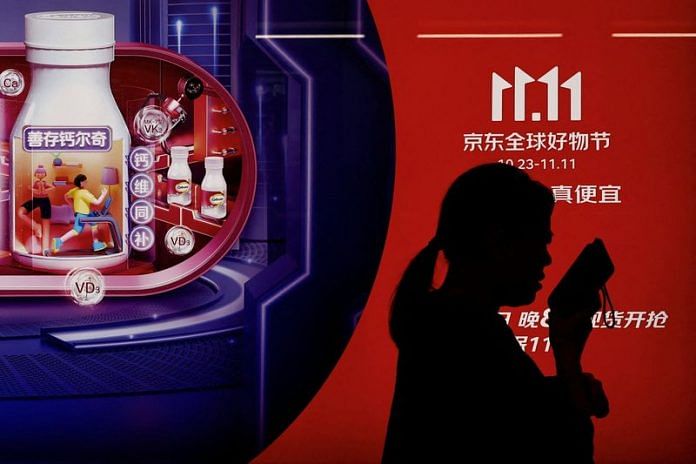By Sophie Yu and Casey Hall
BEIJING (Reuters) – Chinese e-commerce vendors are struggling for survival as sales growth slows, price pressure rises and shopping platforms compete with ever-more aggressive policies to attract increasingly cost-conscious customers.
A once-thriving e-commerce industry punctuated by shopping bonanzas featuring galas and celebrities is bearing the brunt of a sputtering economy that has seen consumers all but tie knots in their purse strings.
While extreme discounting, influencer-led sales campaigns and generous returns policies did much to enrich the sector, those same practices by which vendors have to abide are now hurting those upon which the sector rests.
“The good times for e-commerce are over,” said Shanghai-based e-commerce operator Lu Zhenwang, who sells everyday items for small vendors. “This year there is fierce competition and I don’t think a lot of sellers will survive another three years.”
Profit margins are being squeezed at big platforms such as those of Alibaba and JD.com, but also at the thousands of small businesses which joined the e-commerce boom decade that started around 2013.
That boom has left e-commerce accounting for 27% of retail, with 12 trillion yuan ($1.65 trillion) of goods sold annually.
But as the economy slows, so does e-commerce, with the double-digit growth of recent years set to be replaced by single digits, showed data from Euromonitor.
One outcome is that enthusiasm for participating in sales festivals is noticeably cooling, Lu said, with the biggest – Singles Day, centred on Nov. 11 – a “risky” proposition.
“You have no idea how many products you will be able to sell, but you have to build stock for it,” he said. “It’s almost impossible to see explosive growth during a shopping event.”
BUYER PROTECTION
As the impact of slowdown begins to be felt, vendors are raising their voices against the side effects of sales gimmicks.
During online shopping event “618” – stemming from JD.com’s 18 June founding – the owner of womenswear brand Inman called on authorities to rein in platforms’ “purchase return protection” policies which force sellers to bear the cost of returns.
Such policies started on PDD’s low-price platform Pinduoduo in 2021 and proved so popular that others followed suit – at huge cost to sellers, vendors told Reuters.
“The return rate on e-commerce platforms is 60%,” Inman founder Fang Jianhua wrote on social media. Before such policies, it was about 30%, he said.
Fang said major platforms, upon which vendors rely, should not use “consumer first” policies that add to the burden of businesses, many of which have to sell below cost to maintain high positions in search results amid multiple discount events.
E-commerce operator Lu said return protection policies had caused return rates to soar in categories such as apparel.
Though apparel return rates have always been relatively high, they have jumped since the requirement for buyers to pay for postage when returning goods was scrapped, sellers said.
“Every three pieces of clothes that you sell, at least two pieces will be returned, and you pay for the two-way courier cost,” Lu said.
Pinduoduo, JD.com and Alibaba’s Taobao and Tmall did not respond to requests for comment.
SELLING AT A LOSS
Davy Huang, business development director at e-commerce consultancy Azoya, said consumers had increased the rate at which they return impulse buys, making life tougher for small retailers who do not have sufficient cash flow to bear the cost.
“But I think return rates are just a fraction of the challenges these businesses are facing,” he said. “They also face high traffic acquisition costs and high costs to collaborate with influencers and livestreamers.”
Retailers are also feeling the impact of factories selling directly to consumers at factory prices. Consequently, some vendors on Pinduoduo have been running at a loss for two years, said He-Ling Shi, an economics professor at Monash University in Melbourne.
“They don’t have much hope that prices will eventually be enough to cover their costs, but they have to do it (keep selling via Pinduoduo) otherwise they basically have to close their factories,” Shi said.
Lu said the operating environment is poor because the peaking of e-commerce has created what is known in Chinese as the “neijuan” effect – working harder for smaller returns.
“There is no growth in sales, because there are no new customers and the average income of people is not rising like 10 years ago,” Lu said. “There is only competition, between platforms, between sellers. This is the new normal for the e-commerce industry in China.”
($1 = 7.2709 Chinese yuan renminbi)
(Reporting by Sophie Yu in Beijing and Casey Hall in Shanghai; Editing by Anne Marie Roantree and Christopher Cushing)
Disclaimer: This report is auto generated from the Reuters news service. ThePrint holds no responsibilty for its content.



